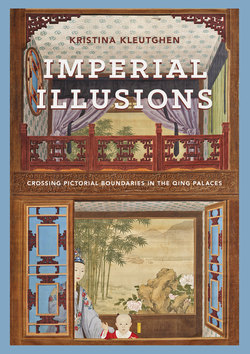Читать книгу Imperial Illusions - Kristina Kleutghen - Страница 60
На сайте Литреса книга снята с продажи.
Оглавление1.9Anonymous court painters,
Portrait of Kangxi Reading,
c. 1700–1705. Hanging scroll, ink
and colors on silk, 137 × 106 cm.
Palace Museum, Beijing,
Gu6411.
time in China—including his Chinese name. He left the Qing court in 1704 as a favored retainer and subsequently became a member of the Royal Academy of Painting and Sculpture in Paris.85 Gherardini may only have been in Beijing for a short time, but without the success of his Qing court service and the paintings he produced while in China, perspectival illusionism might not have had the effect it did on Qing court painting.
One of the few works attributable to Gherardini or his studio is the life-size Portrait of Kangxi Reading (figure 1.9), which depicts the emperor in informal summer robes of rich blue damask with subtle dragon medallions in the same tone and golden metal buttons down the center, in line with the large, lustrous pearl on his red-fringed light summer hat. Kangxi sits cross-legged, likely on a daybed or a kang platform, with a codex-bound book open in front of him, and surrounded by many more books stacked in their colored damask cases on tall two-toned bookshelves that recede perspectivally into the dark and otherwise empty background. Kangxi looks directly out of the painting at the viewer with an inscrutable expression. Unusually, the imperial visage appears visibly shaded and highlighted consistent with a light source originating from the left side of the work (the emperor’s right). Such visible facial shading is all but absent in traditional Chinese portraiture: even Qianlong famously read it as soiled marks on the painting surface, and a portrait of an emperor with a dirty face was utterly unthinkable. Sir John Barrow (1764–1848),
